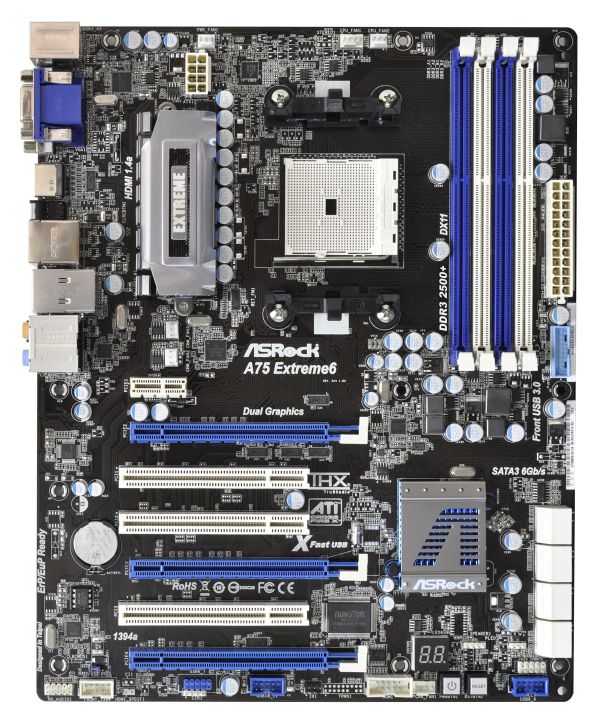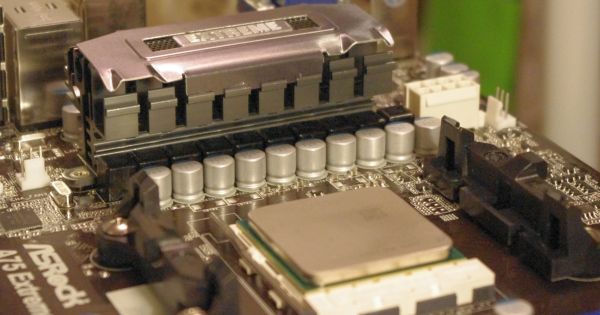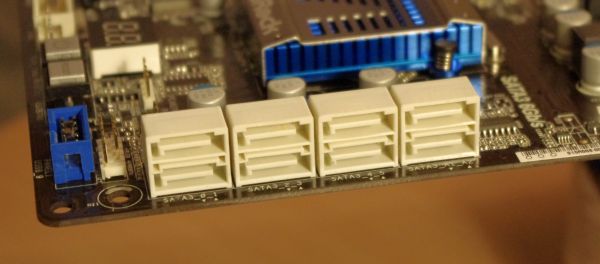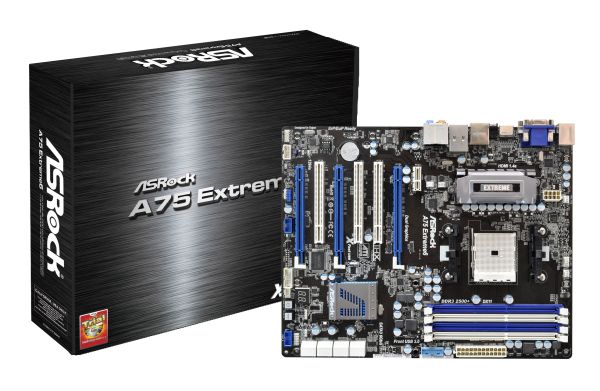ASRock A75 Extreme6 Review and Desktop Llano Overclocking
by Ian Cutress on June 30, 2011 12:05 AM ESTOur initial tests with the ASRock A75 Extreme6 were based on a pre-release model, and shown in our preview. At that point, the board design was not finalized and the BIOS was still quite raw, but the performance was essentially complete. However, now in my grasp is the full release version of the Extreme6. Alongside this standard motherboard review, and testing to see whether it's worth the $150 asking price, we're also going to take a good look at the overclocking features of the Desktop Llano chipset.
I've essentially run our motherboard test suite on two versions of this board now, and having recently played with Cougar Point and AMD Fusion (review to come), it slots nicely in the middle in most aspects - especially CPU power. We're not seeing anything special here with Desktop Llano - as Anand pointed out, in the region of Phenom II X4 performance. For the integrated GPU, it's a different matter, with up to 2x the performance of the highest version of Intel's integrated graphic solutions of the Sandy Bridge second generation Core series. Both of these will come in the form of results I will look at later.
Overview
The ASRock A75 Extreme6 is aimed at the high end Desktop Llano workspace, and, from what ASRock are telling me, will ship in at $150. Unfortunately, I haven't other A75 boards to compare it to yet, but I get the same steady feeling I've got from ASRock boards of late - it's just something that works. There's one minor glitch for now that I've found, to do with memory compatibility, but what we're dealing with here on the board is a good number of features, and the only real downside is the Llano chip itself.
If we look at the prices of the 890 chipset, most motherboards are in the $100-$145 range, so in terms of CPU performance, we're paying a little extra. With the integrated APU at hand, however, you could see where the extra comes from - a different power integration arrangement, and the need for various video output connectors. Personally, I see Desktop Llano more of a niche area, so it will be interesting to see how aggressive the motherboard manufacturers are with pricing.
Visual Inspection
Desktop Llano features the same retention bracket spacing as AM2 and AM3, which, in all honesty, is quite big compared to Intel's chipsets. As a result, we see a bunched up power delivery to the west of the socket itself, covered in a large heatsink of ASRock's design (this is a main difference to the preview board I tested earlier). The chokes on this design are still of the old design - if you can recall, during my tour with ASRock at Computex, I noticed they were using a different choke design on their high end boards to improve power delivery, heat generation and efficiency (similar to MSI's SFC). It seems that the new design still hasn't filtered down into their non-gaming products; despite the fact that I was told that the two choke designs cost the same.
The socket area itself has five fan headers, of which I highly approve and would like to see on every other motherboard on the market - I'm using a Corsair H50, which in dual fan mode requires three (two for fans, one for the pump), so having another couple at hand for case fans is always a plus. Two of the fan headers are labelled for the CPU (one four pin, one three pin), the two under the power delivery are chassis headers (both three pin), and the one above the power delivery is a PWR fan (again, three pin). Elsewhere on the board is one more fan header, labelled as chassis (another three pin).
Beyond the 24-pin ATX connector is a USB 3.0 header, but unfortunately no USB 3.0 bracket comes with this ASRock board like their Sandy Bridge Extreme series. The eight (yes, eight) SATA 6 Gb/s ports come in a couple of flavors - six from the Fusion Controller Hub (FCH), and two more from an ASMedia controller. We also see the Power/Reset/Debug LED combo, which I approve of.
The FCH heatsink is ASRock's low profile, silent design, which actually gets quite warm when anything is overclocked. PCIe design is x1, x16, PCI, PCI, x16, PCI, x4 - with the x16 slots running at x8/x8 mode when two discrete GPUs are being used.
The I/O panel is actually fairly bare, as ASRock haven't decided to stack anything on top of the HDMI. With some extra effort, I'm sure a pair of USBs could be stacked on top of it. Actually, in my initial preview piece, I stated how the USB ports on the far left (physically at the top of the board) were quite tough to get anything in beyond a USB mouse or keyboard if the DVI video out was used. ASRock's response was to 'use a USB port extender - we had to cater for those using DVI + HDMI at the same time', which in my eyes is a stone's throw away from 'oops, we didn't spot that'. Other connectivity comes in the form of a PS/2 port, two native USB 3.0 ports, two USB 3.0 ports from an ASMedia ASM1042 controller, a VGA port, two USB 2.0 ports, an eSATA 3 Gbps port, Realtek controller enabled gigabit Ethernet, a Firewire port, an optical SPDIF out, and the standard audio outputs.















44 Comments
View All Comments
jjj - Thursday, June 30, 2011 - link
no desktop Llano review or there will be one soon?ganeshts - Thursday, June 30, 2011 - link
Coming soon.. We are working on it right now, getting pictures in the engine.FragKrag - Thursday, June 30, 2011 - link
On your conclusion you compared a relatively high end $150 board with budget H67 boards when earlier on in your article you said that the lower end A75 boards would cost around $100.Wouldn't it make more sense to compare a high end A75 board to a higher end H67/Z68 board and a lower end A75 board with the lower end H67? If you did it that way, you would be paying only $25-40 more for Llano over Sandy Bridge.
I do realize you haven't tested one of the $100 A75 boards, but your conclusion seems to be a bit questionable nonetheless.
L. - Thursday, June 30, 2011 - link
Motherboards are going to be much cheaper on the AMD side, as usual.Comparing mobo prices now, and taking a high-end cheap-brand on one side against a cheap board on the other does indeed not make sense.
If it's any indication, my NAS mobo (gigabyte am3) cost like 35 euros. Quite likely that there will be Llano boards around 50 euros before long.
cknobman - Thursday, June 30, 2011 - link
Agreed this article's conclusion is not based off an apples to apples comparison and is really misleading.To the reviewer - please do a better job of trying to compare similar products next time.
qu3ry - Thursday, June 30, 2011 - link
Agreed, and also:"Desktop Llano certainly isn't a low power system - the A8-3850 is rated at 100W, so if you want something to word process, look at emails and play flash games, an AMD Fusion board for $150 will do all that quite easily for all under 60W. "
Alternative: Wait for A8-3800 instead; same IGP but slower clocks (while still faster than say an E-350) @ 65 watts TDP.
Xbitlabs managed to get their hands on A8-3800 silicon which might also be worth reading (no idea what the sites reputation is like so take it with a grain of salt)
http://www.xbitlabs.com/articles/cpu/print/amd-a8-...
ganteng3005 - Thursday, June 30, 2011 - link
What about having a Core i3 2100 + H61 motherboard + Dedicated Radeon HD 6570?It runs faster on both processor and graphics, and the price is equal to the Llano combo.
Other than that --
I love the conclusion part of this article. The cheapest available FM1 A75 motherboard at google shop is currently $103 (if that is true). With the A8-3850, that will end up at $250.
Is Llano a good choice to pick over the i3 2100 for an $25 premium?
Well, it all depends on the user. And the points I would like to make are:
-If you only play flash games, browse the web, type, watch Full HD movies, and use the computer for productivity reasons, pick the Core i3 2100 - the Intel HD graphics will suffice for those flash games - with similar or even better power consumption.
-If you want to do some gaming, then A8-3850 might be the better choice.
Overall, I agree with Anand. I would personally choose the i3 2100 due to its beastial dual-core performance and being able to do anything except heavy GPU stuff - which can be solved by adding a single HD 6570 - and it runs faster than the APU, with the price being similar to the Llano.
TBH, i3 2100 and H61 without any additional GPU will run fine for office desktops. Except if the employees are allowed to play Metro 2033 in office.
AnandThenMan - Thursday, June 30, 2011 - link
What a load of PR rubbish.Exodite - Thursday, June 30, 2011 - link
How so?For mainstream users, which Llano is presumably aimed at, the i3 2100 ends up the better deal as it'll offer better performance in all common tasks.
Llano does have a better native graphics solution, though still not good enough to actually allow for gaming. And if you skip gaming both Llano and the i3 2100 are good enough to handle all other graphics tasks like video and 2D acceleration.
It makes sense to me.
L. - Thursday, June 30, 2011 - link
Stop this please.THERE IS NO SUCH THING AS A COMMON TASK THAT REQUIRES AN i3 2100 !!!
Why do you people keep on throwing that idea around, when it's clear that any basic user (you know, e-mail,facebook,youtube @ home, same @ work + excel, word, stuff) DOES NOT need an i3 (or a Llano for that matter) at all.
Llano has a much much much better graphics solution, which is completely hidden in this biased review as the gpu benchmarks w/ decent RAM are NOT SHOWN (and yes, 2ghz ram is CHEAP today, so anyone buying a Llano should not go for anything lower).
Llano does actually Allow for gaming, the titles tested here only show how with an integrated gpu, you'll be very limited in DEMANDING titles, as Crysis, Metro, ... while NOT demanding titles, like dirt 2 and pretty much everything else, will be fine without _ANY_DEDICATED_GPU_
This will of course not be at maximum settings, but come on, people play on CONSOLES every day, hasn't killed them yet.
I demand a real benchmark, with decent RAMsticks !